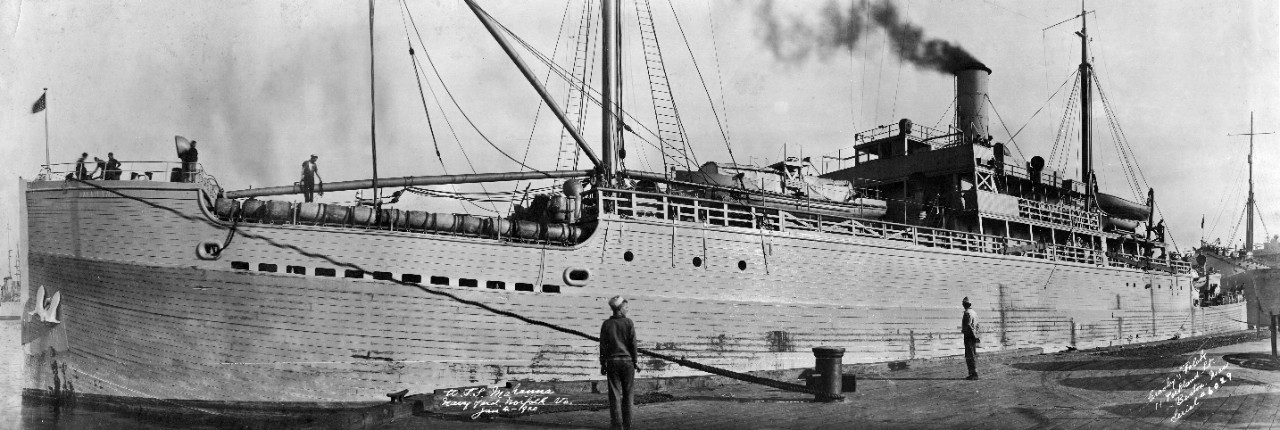Mahanna (AG-8)
1920–1921
The Navy retained the name carried by this vessel at the time of her acquisition.
(AG‑8: displacement 6,125 (light); length 286'0" beam 46'0"; draft 23'3"; speed 10.0 knots (designed); complement 94; armament none)
The wooden-hulled, twin-screw freighter Mahanna was laid down on 20 May 1918 at Astoria, Oregon, by McEachern Ship Co., for the U.S. Shipping Board (USSB), and was launched on 20 November 1918, over a week after the Armistice ended the Great War [World War I]. After Mahanna ran her trials over a measured mile course (12—13 May 1919), the USSB accepted the ship on 27 June 1919, after which time she loaded a cargo of lumber at Hoquiam, Wash., and set out for a voyage to Baltimore, Maryland. She arrived at her destination on 27 August 1919 after having been delayed 17 days during which she underwent repairs to her engines at San Francisco, California. Allocated by the USSB to Patterson, Graham, & Co., of New York City soon thereafter, Mahanna was employed in carrying coal to France, after which she was returned to the USSB late in 1920.
Mahanna’s availability prompted the Navy to acquire the vessel to assist Hannibal (AG-1) in oceanographic survey operations in the West Indies. Consequently, Mahanna was transferred to the Navy at Norfolk, Va., on 20 September 1920; classed as an auxiliary vessel. Given the identification number AG-8, she was commissioned at Norfolk on 29 September 1920, Lt. (j.g.) Emory F. Hosmer in command.
Assigned to the Atlantic Fleet, Mahanna sailed out of Norfolk for survey missions in the West Indies during the next year, cruising between the Caribbean and east coast ports with other survey ships. Congress, however, opted not to fund further survey operations in the West Indies, resulting in the Navy’s decision to decommission Mahanna at Portsmouth, N.H., on 15 September 1921. Returned to the USSB on 2 December 1921, she was stricken from the Navy list.
Soon thererafter, the USSB offered the ship to the Tabor Academy, of Marion, Mass., for use as a training ship to support that independent preparatory school’s marine studies program. Although the vessel seemed appropriate for the purpose, the spectre of staggering maintenance costs led Tabor to scuttle the venture.
Consequently, as the USSB sold off its small wooden fleet, the Boston Iron & Metal Co. of Baltimore acquired Mahanna in February 1922, and stripped her of marketable equipment. When Boston Iron & Metal ultimately settled accounts with the USSB, Mahanna ended up the shipbreakers’ property, to be beached in the backwaters of Chesapeake Bay.
An individual named A. A. Leyare then acquired Mahanna from the city of Baltimore’s Harbor Master in July 1926. A little over a fortnight into the New Year 1929, the former freighter and survey vessel could be seen alongside a pier in South Baltimore, bearing a sign proclaiming her to be the Joy Boat. Featuring a dance hall constructed on the former bridge deck, as well as a player piano and a soft drink bar, the Joy Boat apparently did not prove to be lucrative, for a little over five years later, in September of 1931, she lay at Frederick Town, Md., on the meandering Sassafras River, in the custody of a sheriff, with Mr. Leyare being charged with maintaining a “disorderly house” [of what does not seem to be specified] on board. At that point little more than a “mangled hulk” with 12 feet of foul water stagnating in her lower holds, the Joy Boat, as one chronicler wrote, “mercifully disappears from history.”
Commanding Officer Date Assumed Command
Lt. (j.g.) Emory F. Hosmer 29 September 1920
Updated, Robert J. Cressman
18 July 2022



